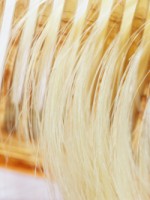|
|
|

Head lice - The Facts: Tiny Ugly Creatures But Nothing To Be Afraid Of!
By Bonnie Kuehl, PhD
Despite the prevalence of lice in Canadian schools each year, at least a third of Canadian parents surveyed (36 per cent) do not feel very confident about identifying lice or nits in their child's hair. Furthermore, more than half of Canadian parents surveyed (56 per cent) reported they would feel distraught, scared it would spread, or embarrassed if their child had lice.
Fact: lice are transmitted as easily as the common cold
- Head lice are transmitted mainly through close head to head contact.
- Children working or playing in small groups are all at risk for transmitting head lice:
- elementary schools
- day cares
- play groups
- parties
- Head lice may also be transmitted by sharing personal items such as:
- combs
- brushes
- towels
- earphones
- hats
- stuffed toys
- pillows
- clothing (especially sweaters or fleeces with hoods)
- Parents, care-givers, and siblings may acquire head lice from younger children through sharing or pillows, beds, towels, and brushes or combs.
- It is important to get rid of lice as soon as possible so that other members of the family or close associates may avoid infestation.
- Head lice are not related in any way to cleanliness and anyone can become infested by them.
Fact: Head lice are annoying but not life-threatening
- Head lice are not known to transmit any diseases to people.
- The most common sign of head lice is persistent itching, especially around the ears. More damage may be done by scratching the scalp than from the lice themselves. A lice infestation can only be proven if live lice or nits (lice eggs) are found in the hair.
- To look for lice examine the head for lice or nits by parting the hair in narrow, vertical sections with a comb or toothpick. Look carefully behind the ears and in the nape of the neck.
Fact: Home remedies have not been clinically proven to work
- There are a number of lice products on the market. Pharmaceutical treatment shampoo or creme rinse products are the most proven method for getting rid of lice. Home remedies or frequent washing with regular shampoo are not effective in getting rid of head lice.
- Only treat people with live lice, not just people who have been exposed to lice.
- Product choices:
- R&CTM 2in 1 Shampoo+Conditioner (a single-step product)
- Kwellada-P® Creme Rinse
- NixTM Creme Rinse
- In most provinces these products are available directly from your pharmacist
Fact: lice products are not used properly
- Follow the treatment instructions exactly. Some lice products are applied to dry hair and others to wet and/or washed hair.
- Leave the product on the hair for the exact length of time indicated in the instructions, no more and no less.
- Remove the nits. This is a time-consuming task but must be done.
- It can take up to 24 hours for lice to die following treatment.
- Apply a second application of the lice product 7-10 days after the first treatment to kill any newly hatched lice.
Fact: if you have a child between 4 and 10 be proactive, learn the facts, it will save time and frustration
- Head lice are common in schools; check your child's head monthly, especially if they are between the ages of 6 and 10.
- If you see live lice, treat immediately and inform the school and friends so that other children can be checked and treated. Re-infestation can occur from a schoolmate or an article of clothing or bedding.
About the author:
Bonnie Kuehl, PhD, Experimental Therapeutics/Cancer Biology, University of Toronto/Ontario Cancer Institute, and an Honours BSc in Biochemistry, University of Guelph. Post-doctoral Fellowships in the laboratories of Sir Professor David Lane, Scotland, U.K. and Dr. Silvia Bacchetti, McMaster University. Key areas of interest include biochemistry as well as cell and molecular biology.
|